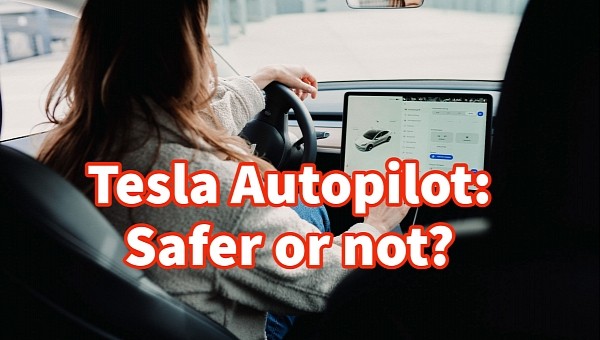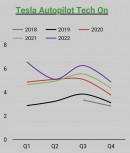Tesla released the Q4 2022 Vehicle Safety Report, showing that safety has improved compared to the years before. Even so, it looks a lot worse than in the third quarter because the winter months are inherently less safe for driving.
People say that if you look long enough, you'll find statistics and studies to prove anything, even opposing theories. In the case of Tesla Vehicle Safety Reports, you don't have to look very deep. Depending on where you're standing, you can see them as a good or bad sign. Take the Q4 2022 Autopilot safety statistics, for instance. The numbers show that safety has significantly degraded compared to the previous quarter. If you look at the Q4 data of earlier years, you see that the safety has actually improved year over year.
According to the latest data, Tesla recorded one crash for every 4.85 million miles driven with Autopilot engaged. This compares favorably to the one crash every 1.4 million miles driven by Tesla drivers without Autopilot. The latest NHTSA statistics from 2021 show that human drivers cause a crash for every 652,000 miles driven. If you recall, Tesla recorded one Autopilot crash for every 6.26 million miles driven in Q3 2022.
The Q4 2022 report shows safety took a hit, but this has happened in all years. Driving in the winter is inherently more dangerous because of reduced daylight and inclement or wintry weather conditions. Looking at all Q4 data in previous years, we can see that Autopilot driving has improved safety every year. On the other hand, the human drivers' safety records and non-Autopilot safety for Tesla drivers have remained constant. This is an important trend if Tesla data are to be believed (and we have no reason not to believe them).
With all the vehicles in its fleet connected and reporting every road incident, Tesla is unique in the automotive industry to offer such data. Other car brands do not collect accident analytics, and the available statistics rely on NHTSA reports. Tesla reports include all crashes in which the incident alert indicated an airbag or other active restraint deployed, as well as any crash in which Autopilot was deactivated within 5 seconds before impact. Tesla says this correlates to nearly any collision at about 12 mph (20 kph) or above, depending on the crash forces generated.
Despite offering this data, Tesla's approach is far from being undisputed. Tesla stopped offering safety data last year after releasing the Q4 2021 report. It changed course again in January, when it provided the missing reports, but recalculated everything based on new criteria. This has made people question Tesla's honesty, as the latest reports looked better than the old ones. Critics also pointed out that Autopilot data analyzed mostly highway driving, whereas NHTSA crash data also included city and country roads, where most crashes occur.
According to the latest data, Tesla recorded one crash for every 4.85 million miles driven with Autopilot engaged. This compares favorably to the one crash every 1.4 million miles driven by Tesla drivers without Autopilot. The latest NHTSA statistics from 2021 show that human drivers cause a crash for every 652,000 miles driven. If you recall, Tesla recorded one Autopilot crash for every 6.26 million miles driven in Q3 2022.
The Q4 2022 report shows safety took a hit, but this has happened in all years. Driving in the winter is inherently more dangerous because of reduced daylight and inclement or wintry weather conditions. Looking at all Q4 data in previous years, we can see that Autopilot driving has improved safety every year. On the other hand, the human drivers' safety records and non-Autopilot safety for Tesla drivers have remained constant. This is an important trend if Tesla data are to be believed (and we have no reason not to believe them).
With all the vehicles in its fleet connected and reporting every road incident, Tesla is unique in the automotive industry to offer such data. Other car brands do not collect accident analytics, and the available statistics rely on NHTSA reports. Tesla reports include all crashes in which the incident alert indicated an airbag or other active restraint deployed, as well as any crash in which Autopilot was deactivated within 5 seconds before impact. Tesla says this correlates to nearly any collision at about 12 mph (20 kph) or above, depending on the crash forces generated.
Despite offering this data, Tesla's approach is far from being undisputed. Tesla stopped offering safety data last year after releasing the Q4 2021 report. It changed course again in January, when it provided the missing reports, but recalculated everything based on new criteria. This has made people question Tesla's honesty, as the latest reports looked better than the old ones. Critics also pointed out that Autopilot data analyzed mostly highway driving, whereas NHTSA crash data also included city and country roads, where most crashes occur.
Tesla’s Autopilot achieved a record high safety level for the 4th qtr of any year in Q4 2022, with just one crash for every 4.85M miles driven. This compares to the avg US driver with one crash every 652k miles.
— Sawyer Merritt (@SawyerMerritt) March 13, 2023
Note: Q4 numbers are lowest due to winter/snow/ice & less daylight. pic.twitter.com/xRjUWljWur







